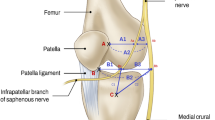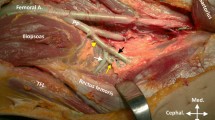Abstract
Hamstrings identification and subsequent graft harvest can be made difficult by body habitus and variability in tendon anatomy. We describe a ‘sentinel’ blood vessel near the insertions of gracilis and semitendinosus to facilitate identification. A prospective study of 100 patients (100 knees) undergoing primary arthroscopic ACL reconstruction (via the anterior approach) with hamstrings graft was conducted. We searched for a ‘sentinel’ vessel and studied its position, orientation and perpendicular distance from the pes tendons. The ‘sentinel’ vessel was present in 98/100 knees. It passed from the superficial fascia to the periosteum at the pes insertion at a mean perpendicular distance of 8 mm from the upper border of the pes tendons. The ‘sentinel’ vessel was a consistent anatomical finding and served as a reliable guide in determining the pes insertion. Identifying this anatomical landmark allowed a small skin incision with limited wound dissection minimising risk of injury to the infra-patellar branch of the saphenous nerve.

Similar content being viewed by others
References
Solman CG, Pagnani MJ (2003) Hamstrings tendon harvesting: reviewing anatomic relationships and avoiding pitfalls. Orthop Clin N Am 34:1–8
Pagnani MJ, Warner JJP, O’Brien SJ et al (1993) Anatomic considerations in harvesting the semitendinosus and gracilis tendons and a technique of harvest. Am J Sports Med 21:565–571
Warren LF, Marshall JL (1971) The supporting structure and layers on the medial side of the knee. J Bone Joint Surg 61:56–62
Prodromos CC, Han YS, Keller BL et al (2005) Posterior mini-incision technique for hamstring anterior cruciate ligament reconstruction graft harvest. Arthroscopy 21:130–137
Wilson T, Lubowitz J (2013) Minimally invasive posterior hamstring harvest. Arthrosc Tech 2(3):e299–e301
Zaffagnini S, Golano P, Farinas O et al (2003) Vascularity and neuroreceptors of the pes anserinus: anatomic study. Clin Anat 16(1):19–24
Mochizuki T, Muneta T, Yagishita K et al (2004) Skin sensory change after anterior cruciate ligament reconstruction using medial hamstrings tendons with a vertical incision. Knee Surg Sports Traumatol Arthrosc 12:198–202
Bertram C, Porsch M, Hackenbroch MH et al (2000) Saphenous neuralgia after arthroscopically assisted anterior cruciate ligament reconstruction with a semitendinosus and gracilis graft. Arthroscopy 16:763–766
Arthornthurasook A, Gaew-Im K (1990) The sartorial nerve: its relationship to the medial aspect of the knee. Am J Sports Med 18:41–42
Arthornthurasook A, Gaew-Im K (1988) Study of the infrapatellar nerve. Am J Sports Med 16(1):57–59
Kartus J, Ejerhed L, Eriksson BI et al (1999) The localization of the infrapatellar nerves in the anterior knee region with special emphasis on central third patellar tendon harvest: a dissection study on cadaver and amputated specimens. Arthroscopy 15:577–586
Portland GH, Martin D, Keene G et al (2005) Injury to the infrapatellar branch of the Saphenous nerve in anterior cruciate ligament reconstruction: comparison of horizontal vs. vertical harvest site incisions. Arthroscopy 21(3):281–285
Papastergiou SG, Voulgaropoulos H, Mikalef P et al (2006) Injuries to the infrapatellar branch of the saphenous nerve in anterior cruciate ligament reconstruction with four-strand hamstring tendon autograft: vertical versus horizontal incision for harvest. Knee Surg Sports Traumatol Arthrosc 14:789–793
Author information
Authors and Affiliations
Corresponding author
Ethics declarations
Conflict of interest
The authors declare that they have no conflict of interest related to the publication of this manuscript.
Informed consent
The study was authorised by the local ethical committee and was performed in accordance with the ethical standards of the 1964 Declaration of Helsinki as revised in 2000.
Additional information
Publisher's Note
Springer Nature remains neutral with regard to jurisdictional claims in published maps and institutional affiliations.
Rights and permissions
About this article
Cite this article
Babu, S., Gupte, C., Gajjar, S. et al. The ‘sentinel’ vessel: an anatomical landmark to identify the pes anserinus during hamstrings harvest for ACL reconstruction. Eur J Orthop Surg Traumatol 29, 1115–1118 (2019). https://doi.org/10.1007/s00590-019-02408-4
Received:
Accepted:
Published:
Issue Date:
DOI: https://doi.org/10.1007/s00590-019-02408-4




